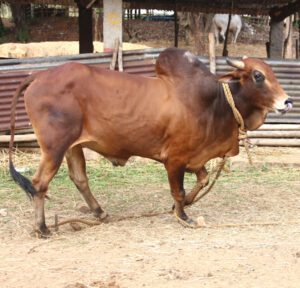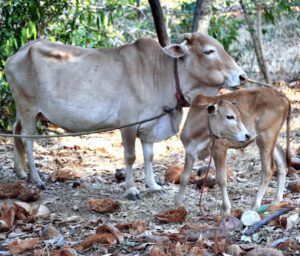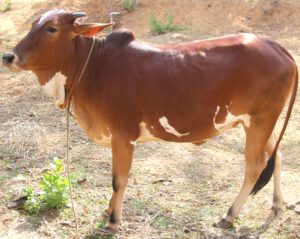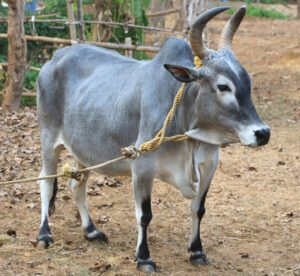Alambadi cattle is an indigenous, wonderful breed originated from Alambadi of Dharmapuri district in Tamil Nadu state of India. Now Alambadi is a quite rare breed. This cattle breed is mainly raised in the hilly regions of modern-day Tamil Nadu.
Modern cattle breeders are attempting to increase the milk production of this traditional Indian breed. Previously, the breed was usually kept as a drought animal. The farmers around India should extend a helping hand for the conservation of the Alambadi cattle.
The positive news is that ‘the State Government of Tamil Nadu has taken effective steps for the conservation of this breed’. Review specialties, characteristics and full breed profile below.
Specialties of Alambadi Cattle
Alambadi cattle are actually an unique Indian cattle breed known for their distinct characteristics. They are very beautiful and known for their hardiness.
Learning about the specialties of a breed is very important. That’s why, here we are going to describe about the specialties of Alambadi breed.
1. Historical Background
The historical background of Alambadi cattle is deeply intertwined with the cultural and agricultural tapestry of India. It is an ancient breed of domestic cattle originating in the Alambadi region of Tamil Nadu
These cattle have been part of India’s landscape for centuries. And they are renowned for their distinct characteristics, including glossy black or dark brown coats and graceful lyre-shaped horns.
They have been steadfast companions to farmers, assisting with plowing and transport, and have been central figures in religious ceremonies and festivals.
2. Adaptability and Hardiness
Alambadi cattle are well known for their remarkable adaptability and extreme hardiness. They are resilient cattle breed, and they can thrive in a diverse range of climatic conditions. Thats why they are a dependable choice for farmers across India.
Whether in the scorching heat of the South or the rugged terrain of the Western Ghats, Alambadi Cattle demonstrate their ability to endure and prosper.
They have robust immune systems which grant them a natural resistance to common cattle diseases, reducing the need for intensive veterinary care.
They are excellent as foragers, and they efficiently utilize diverse vegetation types. And they are well-suited to a variety of environments.
3. Milk Production
Alambadi cows are not renowned for high milk yields like many other common and popular dairy breeds. But they offer a unique and valuable contribution to milk production.
Their milk is characterized by it’s rich quality and high-fat content, and the milk is highly regarded for producing exceptional dairy products like ghee.
Their primary role in some regions may be as draught animals, but the milk they provide is an essential resource for nourishing their calves and supporting local communities.
Alambadi cow’s milk may not flow in abundance, but it’s nutritional richness and versatility make it an integral part of traditional Indian cuisine and culture, cherished for generations.
4. Cultural and Traditional Significance
Alambadi cattle hold a profound cultural and traditional significance in the southern regions where they were originated from. They are not just livestock; they are living symbols of India’s rich heritage.
These cattle play a very important role in religious rituals, agricultural festivals, and ceremonies, symbolizing prosperity and abundance.
The sight of decorated Alambadi cattle during these events invokes a sense of cultural continuity and reverence for the deep-rooted traditions they represent. Beyond their practical utility in farming, Alambadi cattle embody the spiritual and cultural connections that bind communities to their agricultural roots.
5. Conservation Efforts
Efforts to conserve Alambadi cattle are gaining momentum as recognition of their unique genetic heritage grows. Conservation initiatives are focused on preserving the genetic purity of this indigenous breed and raising awareness about it’s importance.
These efforts involve controlled breeding programs, community involvement, and the promotion of Alambadi cattle as a sustainable and economically viable livestock option.
Conservationists, government agencies, and NGOs are collaborating to safeguard this breed from the threat of crossbreeding and habitat loss, ensuring that future generations can continue to benefit from its adaptability, historical significance, and cultural value.
6. Challenges and Threats
Alambadi cattle face several significant challenges and threats. One of the foremost concerns is the risk of crossbreeding with other cattle breeds, which can dilute their unique genetic traits.
Habitat loss due to urbanization and deforestation also threatens their natural environments. Changing agricultural practices that reduce the demand for draught animals pose a challenge to their continued relevance.
However, despite these challenges, ongoing conservation efforts and increased awareness offer hope for the preservation of Alambadi breed as they remain an enduring symbol of India’s agricultural and cultural heritage.
Alambadi Cattle Characteristics
Alambadi cattle is medium in size and is grey, dark grey or black in color. Some other colors are also available in some areas. There are white markings in the forehead, limb and tail of this cattle breed. Their head is narrow and horns are backward curving.
The forehead and hump are prominent, with a thick dewlap also present. On average, an adult Alambadi bull weights about 317-362 kg and cow about 290 kg.
Alambadi cattle are very beautiful and lovey animals. Their distinctive characteristics, adaptability, and role in both agriculture and culture make them a valuable and unique breed.
As efforts to conserve indigenous cattle breeds gain momentum, it is essential to recognize and celebrate the remarkable qualities that set Alambadi cattle apart, ensuring their continued presence in India’s rural landscape.
Alambadi is actually an unique and indigenous breed of India. And they have long been admired for their distinctive characteristics. They are not only a testament to India’s rich agricultural heritage but also play a crucial role in the country’s rural economy.
Physical Characteristics
One of the most striking features of Alambadi cattle is their appearance. They are medium-sized animals with a compact and well-built body. They are predominantly black or dark brown, with a glossy coat that reflects their good health.
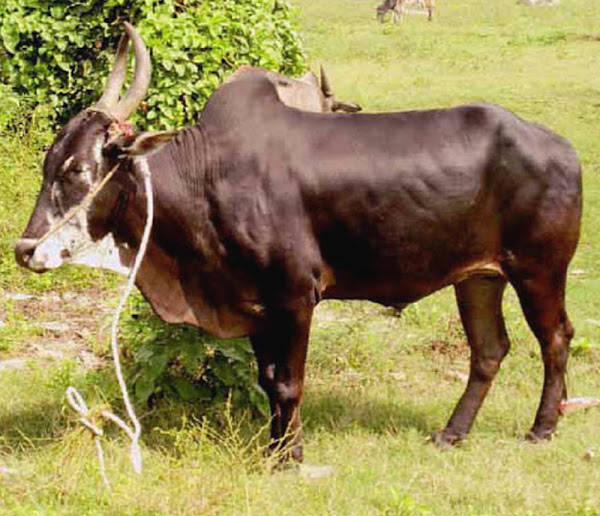
They have long, lyre-shaped horns that sweep backward and slightly upward, giving them an elegant and majestic look. Their face is broad and expressive, with dark eyes and a gentle disposition. Their hooves are strong and well-suited for traversing rough terrains, which is crucial in their native hilly and forested regions.
Hardiness
Alambadi is a well known and hardy cattle breed and they are renowned for their adaptability and hardiness. These traits are essential in the diverse and often challenging environments of India.
These cattle are well-suited to withstand a wide range of climatic conditions. They can thrive in the scorching heat of South India as well as in the cold and hilly regions of the Western Ghats.
Their robust immune system and resistance to common cattle diseases make them a preferred choice for farmers who value low-maintenance livestock. These cattle are excellent foragers, capable of finding nourishment in diverse vegetation types, including forests, grasslands, and agricultural fields.
Milk Production
While Alambadi cows are not typically known for their high milk yield compared to specialized dairy breeds, they do contribute to the local milk supply. The milk they produce is notable for its quality and richness.
Alambadi cow’s milk is rich in fat content, making it ideal for producing high-quality ghee and other dairy products prized in Indian cuisine. Many farmers raise this Alambadi breed primarily for their calves, as the milk produced is often reserved for nourishing the young animals.
Uses
Alambadi cattle is almost exclusively a drought breed. In India, the breed is kept mainly for pulling cart and ploughing. They are not among the good milkers, and rarely used for dairy farming.
Housing
Proper housing is very important for raising Alambadi cattle. This is very essential to ensure their well-being. These cattle require shelter that offers protection from harsh weather conditions, be it scorching heat, heavy rain, or cold.
Adequate ventilation is important to prevent respiratory issues, and maintaining cleanliness in the shelter helps minimize health risks.
Try to provide them with ample shade and a comfortable, dry environment is essential to keep Alambadi cattle content and healthy.
A well-designed shelter not only safeguards their physical health but also contributes to their overall comfort and productivity, making it a crucial element in successful cattle farming.
Feeding
Feeding the animals with very good quality and nutritious food is the most important part of raising these cattle breed. Alambadi cattle’s nutrition plays a vital role in their health and productivity.
While they predominantly graze on natural pastures, supplementing their diet with balanced feed can be essential, especially for specific purposes like milk or meat production.
Always try to provide them with enough clean and fresh water. Try to understand the nutritional needs of Alambadi cattle and provide them with high-quality forage and supplementary feeds.
Ensure they receive the necessary nutrients for good growth, milk production, and overall well-being. Careful attention to their diet is a key component of successful Alambadi cattle management.
Breeding
Breeding desi cattle is very easy and simple. Alambadi cattle breeding is a vital aspect of preserving this unique indigenous breed. Careful selection of breeding pairs is essential to maintain their genetic purity and promote desirable traits.
Breeding age varies but typically starts at 15-18 months for heifers and 18 months for bulls. Keep detailed breeding records and it will help to monitor the reproductive health of the herd and track lineage information.
Caring
Caring for Alambadi cattle is relatively easy and simple. They are extremely strong and hardy and generally require less caring and other management. Try to provide them with proper shelter, nutrition, and veterinary care to fostering a positive and respectful relationship.
Ensure access to clean and fresh drinking water, nutrient-rich pasture, and supplementary feed when needed. And doing this is very important for their health and productivity.
Regular veterinary check-ups, vaccinations, and parasite control help maintain their well-being. Handling Alambadi cattle gently and patiently, along with proper training, fosters trust and ease of management.
Best Tips for Raising Alambadi Cattle
Raising Alambadi cattle is relativey easy and simple, because they are extremely strong and hardy animals. They are known for their distinctive characteristics, historical significance, and cultural importance. However, here we are going to share some important tips for raising these beautiful animals.
1. Make a Business Plan
First of all, make a good and effective business plan before starting this business. A good business plan helps to run your farm perfectly without any problem. Ask for help from an expert if you are new in this business. Try to include everything in your business plan from starting to marketing.
2. Try to Understand Alambadi Breed
Before you start raising Alambadi cattle, it is crucial to understand their unique features. You should recognize their historical and cultural significance in India, including their role in religious rituals and festivals.
You should also understand the various purposes of this cattle breed, including draught work and milk production.
3. Purchase Healthy Animals
The foundation of a successful Alambadi cattle herd begins with healthy animals. Try to obtain healthy and active animals from reputable breeders who prioritize the health and genetics of their cattle.
Conduct a thorough physical examination to ensure your selected animals are free from diseases or deformities. Request vaccination records to ensure the cattle have received necessary vaccinations.
4. Arrange Good Shelter
Providing proper shelter is very essential for the comfort and well-being of your cattle. So, try to provide your animals with a secure and comfortable shelter.
Ensure that the shelter offers shade and protection from harsh weather conditions, such as heavy rain and extreme heat. Maintain proper ventilation to prevent respiratory issues and promote air circulation.
And always try to keep the shelter clean and dry to minimize the risk of diseases, infections and other health problems. Also ensure enough space per animal inside the house.
5. Provide Them Nutritious Food 7 Clean Water
Providing a balanced diet to your animals is very important for the health and productivity of Alambadi cattle. Provide access to fresh and nutrient-rich pasture for grazing.
Along with fresh green foods, try to supplement their diet with appropriate feed. And always ensure they have constant access to clean and fresh water.
6. Ensure Regular Veterinary Care
Regular veterinary care is crucial for maintaining the health of your herd. Follow a veterinarian-recommended vaccination schedule to protect your cattle from common diseases and health problems.
Try to implement an effective parasite control program to prevent infestations and maintain the health of your animals.
Schedule regular check-ups to detect and address health issues promptly. Have a plan ready for immediate veterinary care in case of injuries or severe illnesses.
7. Ensure Enough Exercise and Social Interaction
Alambadi cattle are active animals that benefit from exercise and social interaction. Allow them ample time for grazing and foraging, which also provides mental stimulation.
Spend time with your cattle to build trust and a strong bond, making them more manageable. Provide an exercise yard where they can move freely and engage in natural behaviors.
8. Breeding Management
Effective breeding management is also very important for raising Alambadi cattle. Know the appropriate age for breeding from an experienced breeder. The Alambadi heifers can be bred at 15-18 months, while bulls can start at 18 months.
Maintain detailed breeding records to track reproductive health and optimize breeding outcomes. Avoid close inbreeding to maintain the genetic diversity of the breed. And doing this is very important.
9. Handling and Training is Also Important
Proper handling and training are also essential for the safety of both cattle and handlers. Use a gentle and patient approach when handling these cattle, as they respond well to calm interactions.
Train your cattle for basic commands, such as leading and loading onto trailers, to make management easier. And try to learn about your cattle behavior to understand their cues and signals, facilitating better handling.
10. Pasture Management
Effective pasture management is vital for providing adequate nutrition to your animals. Implement rotational grazing to prevent overgrazing and ensure that pasture remains nutritious. Consider soil testing and fertilization to improve the quality of the forage.
11. Ensure Fencing and Enclosures
Proper fencing and enclosures are essential for herd security. Use sturdy fencing to keep your cattle safe from predators and prevent them from straying. Also ensure there are escape routes or gates for emergencies.
12. Climate Considerations
Alambadi cattle are adaptable, but climate can impact their health. Provide shade and access to water during hot weather to prevent heat stress. But in colder regions, ensure that your cattle have protection from extreme cold.
13. Regularly Monitor Their Health
Regularly monitor the health of your cattle, and doing this is very important. Track the weight of your cattle to ensure they maintain a healthy condition. Pay attention to changes in behavior, as they can indicate health issues and take necessary steps.
14. Keep Records
Maintaining accurate records of everything for your herd is very important. Keep detailed health records, including vaccinations, treatments, calving dates, total costs etc. Document breeding dates, outcomes, and lineage information.
Keeping records of everything will help you to run your farm better.
15. Implement Biosecurity Measures
Implementing biosecurity measures is also very important to prevent disease spread. Quarantine new cattle arrivals to ensure they are disease-free before introducing them to your herd. Maintain a clean and hygienic environment to reduce the risk of infections.
16. Ensure Good Marketing Strategies
If you plan to sell Alambadi products, develop effective marketing strategies. And without a good marketing plant, your venture will not be much profitable. So, try to determine your marketing strategies before starting this business.
Explore local markets and networks to sell milk, milk products or breeding stock. Consider producing value-added products like cheese or ghee to diversify your offerings. And doing this will make your marketing strategies much easy.
Special Notes
Alambadi cattle is a very hardy animal, and is very useful in ploughing. And can withstand all climatic conditions. Alambadi cows give good amount of milk.
The farmers can improve their economic condition by raising this cattle breed. Review full breed profile of this cattle breed in the chart below.
| Breed Name | Alambadi |
| Other Name | None |
| Breed Purpose | Mainly kept for ploughing and pulling cart. Rarely kept for dairy. |
| Special Notes | Very hardy |
| Breed Size | Medium |
| Weight | 290-362 kg |
| Climate Tolerance | All Climates |
| Skin Color | Grey, dark grey or black |
| Horned | Yes |
| Milk Yield | Poor |
| Rarity | Rare |
| Varieties | Mainly Grey, Dark Grey or Black |
| Country of Origin | India |
Related Queries & FAQs
There are lots of questions and queries related to Alambadi cattle. Here we are trying to list the common questions and queries about this beautiful cattle breed. Hope you will find answers of your questions or queries. Don’t hesitate to ask us if you have more questions.
Tell me some basic information about Alambadi cattle.
Alambadi is an indigenous cattle breed that originated in the Alambadi region of Tamil Nadu, India. They are known for their unique physical characteristics and historical significance. They are very beautiful with distinctive appearance.
What are the distinctive characteristics of Alambadi cattle?
Alambadi is a very beautiful cattle and they are medium-sized with a glossy black or dark brown coat. They have lyre-shaped horns that sweep backward and a broad, expressive face.
What is the historical significance of Alambadi cattle?
Alambadi cattle have a rich history in Indian agriculture and culture. They have been used for various purposes, including draught work, milk production, and religious ceremonies.
What is the primary purpose of raising Alambadi cattle?
Alambadi cattle serve multiple purposes, including draught work in agriculture and milk production.
Are Alambadi cattle good for milk production?
While they may not be high-yield dairy cattle like specialized breeds, Alambadi cows produce milk of good quality, often used for making ghee and other dairy products.
How do Alambadi cattle adapt to different climates?
Alambadi cattle are known for their adaptability to various climatic conditions. They can thrive in the hot and humid regions of South India as well as the cold and hilly areas of the Western Ghats.
Are there any conservation efforts in place for Alambadi cattle?
Yes, there are ongoing conservation initiatives aimed at preserving the genetic purity of Alambadi cattle and raising awareness about their importance.
What are the challenges facing Alambadi cattle conservation?
Challenges include crossbreeding with other cattle breeds, habitat loss due to urbanization and deforestation, and changing agricultural practices that reduce the demand for draught animals.
Are there specific breeding programs for Alambadi cattle?
Yes, controlled breeding programs have been established to maintain the genetic purity of Alambadi cattle and improve their overall characteristics.
Are Alambadi cattle used in religious rituals and festivals?
Yes, Alambadi cattle are often featured in religious rituals and agricultural festivals in India, where they play a significant role.
Do Alambadi cattle require special care or attention compared to other cattle breeds?
While Alambadi cattle are known for their hardiness and adaptability, they do benefit from proper shelter, nutrition, and regular veterinary care, like any other cattle breed.
Are there specific tips for raising Alambadi Cattle successfully?
Successful raising of Alambadi cattle involves considerations such as selecting healthy calves, providing proper shelter and nutrition, and participating in conservation efforts.
What is the typical lifespan of Alambadi cattle?
With proper care and management, Alambadi cattle can live for 15 to 20 years or more, depending on individual health and environmental conditions.
Are there any specific dietary requirements for Alambadi cattle?
They primarily graze on natural pasture, supplementary feeding might be necessary based on your specific goals, such as milk or meat production. Consult with a veterinarian or cattle nutritionist for balanced dietary recommendations.
Can Alambadi cattle be used for draught work in modern agriculture?
Yes, they can still be valuable for draught work in regions where traditional farming practices are prevalent. Their adaptability and strength make them suitable for plowing and other agricultural tasks.
How can I get involved in Alambadi cattle conservation efforts?
You can support conservation initiatives by participating in breeding programs, spreading awareness about the breed’s importance, and connecting with local organizations dedicated to breed preservation.
What are the economic prospects of raising Alambadi cattle?
The economic viability of raising Alambadi cattle depends on factors such as market opportunities for their products, including meat and dairy, as well as potential value-added products like ghee or traditional medicines.
Do Alambadi Cattle require specialized veterinary care?
They do not require specialized care, regular veterinary check-ups, vaccinations, and parasite control are essential for their health and well-being.
Can Alambadi cattle be crossbred with other cattle breeds?
While crossbreeding can occur, it is generally discouraged to preserve the genetic purity of Alambadi cattle. Crossbreeding can lead to the loss of their unique characteristics and traits.

